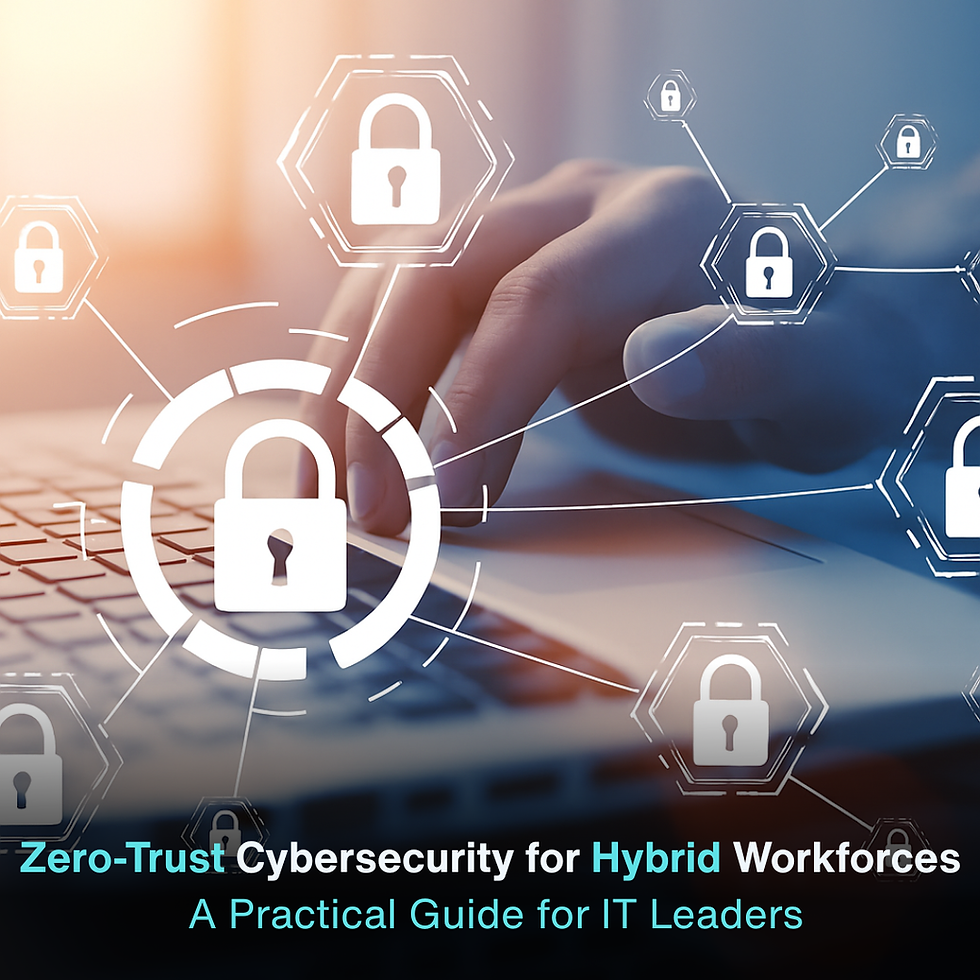Zero-Trust Cybersecurity for Hybrid Workforces: A Practical Guide for IT Leaders
- Editorial Team

- Oct 28
- 3 min read
Updated: Nov 21

Introduction: Why Zero Trust Is No Longer Optional
In 2025, cybersecurity is not just a defensive measure—it’s a strategic advantage. With remote and hybrid work becoming the default for many organizations, the traditional security perimeter has all but disappeared. Employees connect from home networks, personal devices, and public Wi-Fi—expanding the potential attack surface exponentially. This is where Zero-Trust Security comes in. Its philosophy is simple yet powerful: “Never trust, always verify.” For IT leaders, adopting a zero-trust framework is now mission-critical—not just to protect systems and data, but to ensure business continuity, customer confidence, and compliance in a distributed workforce environment.
1. Understanding Zero Trust in Today’s Context
Zero Trust isn’t a single product or platform—it’s a comprehensive security model built around the principle that no user, device, or application should be trusted by default, even if it operates inside the corporate network. Unlike traditional models that assume safety within the perimeter, Zero Trust treats every access attempt as a potential threat until verified.
Core Pillars of Zero Trust
Identity Verification – Authenticate every user through multi-factor or adaptive access.
Device Integrity – Continuously assess device health and security posture.
Least-Privilege Access – Grant users only the permissions they need, nothing more.
Micro-Segmentation – Divide networks into smaller, isolated zones to prevent lateral movement.
Continuous Monitoring – Detect anomalies in real time through behavioral analytics.
2. The Hybrid Work Challenge: Why Security Perimeters No Longer Work
The rise of hybrid workforces has erased the traditional network boundary. Employees now access sensitive systems from personal laptops, mobile devices, and cloud-based tools. This shift has made VPN-based security and perimeter firewalls insufficient. Threats can come from within or outside the organization at any time. A Zero-Trust Architecture (ZTA) provides the agility and security modern IT environments demand—especially in hybrid ecosystems where employees, contractors, and partners access the same cloud resources.
Key Risks of Traditional Security in Hybrid Work
Compromised personal devices connecting to the network.
Unsecured Wi-Fi networks exposing sensitive data.
Cloud misconfigurations leading to data leaks.
Increased phishing and ransomware attacks on remote employees.
Zero Trust ensures that even if one component is compromised, attackers can’t move freely across systems.
3. Implementing Zero Trust: A Practical Roadmap for IT Leaders
Step 1: Identify and Classify Data
Start by mapping your organization’s data assets—understand where sensitive data resides, who accesses it, and how it’s being shared. This visibility forms the foundation for all zero-trust controls.
Step 2: Strengthen Identity and Access Management (IAM)
Adopt multi-factor authentication (MFA), single sign-on (SSO), and passwordless authentication. Use behavioral analytics to detect unusual login patterns or location anomalies.
Step 3: Secure Endpoints and Devices
Deploy endpoint detection and response (EDR) tools and ensure patch management is automated. Regularly monitor device compliance, encryption, and firmware status.
Step 4: Apply Least-Privilege and Role-Based Access
Implement role-based access control (RBAC) to minimize exposure. Users should access only the data and systems relevant to their job functions.
Step 5: Adopt Micro-Segmentation and Network Visibility
Break the network into isolated zones, limiting access between workloads. Use network detection and response (NDR) tools for visibility across hybrid and multi-cloud environments.
Step 6: Continuous Monitoring and Incident Response
Real-time threat detection powered by AI and automation enables faster responses. Invest in Security Information and Event Management (SIEM) systems for proactive defense.
4. The Business Case for Zero Trust
While implementing Zero Trust requires investment in tools and training, it delivers measurable ROI in the form of:
Reduced Breach Risk: Stops lateral movement of attackers.
Improved Compliance: Meets requirements like GDPR, HIPAA, and ISO 27001.
Operational Agility: Enables secure remote access without friction.
Customer Confidence: Strengthens brand reputation by demonstrating proactive security.
In a hybrid work model, trust must be earned continuously, not assumed once. Zero Trust aligns cybersecurity with modern digital business goals.
5. Looking Ahead: The Future of Secure Hybrid Work
As AI-driven threats and deepfakes become more sophisticated, Zero Trust will evolve into Adaptive Trust, where policies adjust dynamically based on real-time context. Automation, threat intelligence, and behavioral learning will drive the next phase of cybersecurity—allowing systems to predict and neutralize risks before they cause harm. Organizations that embrace this now will not only safeguard their data but also gain a competitive edge in trust, compliance, and resilience.
Conclusion: Zero Trust as a Strategic Imperative
Zero Trust is more than a cybersecurity framework—it’s a cultural shift toward continuous verification, transparency, and accountability. For IT leaders navigating the complexities of hybrid work, it represents the blueprint for digital trust in a borderless world. In 2025 and beyond, businesses that master Zero Trust won’t just survive—they’ll lead confidently in the age of distributed innovation.


Comments